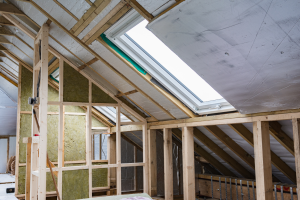If you’re looking to extend your home upwards or out, then you may have heard of party wall agreements. Whether this applies to you depends on the type of your home, the nature of the work that is being undertaken in your loft conversion and if there will be any changes to the ‘party wall., i.e., the dividing partition between the two adjoining buildings that is shared by the occupants of each home.

Does a party wall agreement apply to me?
This mainly depends on your type of home. A detached or standalone house would not require any party wall agreements unless it affected a neighbour’s boundaries, which would be more garden related. Living in a terraced house or semi-detached house would probably require a party wall agreement, however. If you have neighbours on both sides in a terrace, both neighbours would need to be informed and to seek a party wall agreement.
If the nature of the work included placing a beam and column to support your conversion without needing to make any works to the party wall, you would not need to seek one. However, you may need seek a party wall agreement if you are proposing to do any of the following in your loft conversion project:
-Cut the shared wall and/or use it as a load bearing wall for a beam
-Insert a damp proof course for the whole length of the wall
-Demolish and/or rebuild part of the wall
-Increase the height or thickness of the wall
-Cut any projections off the party wall
-Remove a chimney breast from a party wall
-Underpin the whole thickness of the party wall
Minor work such as installing electrical wiring or plug sockets or shelving conversely would probably not need the approval of your neighbours.
So what is a party wall agreement?
Essentially a party wall agreement is consent from your neighbours that they agree to works being undertaken to any shared boundaries of your properties. In this case, it refers to shared loft spaces or the beams in between. However, a party wall agreement can be made even if your neighbours do not consent.

How do I serve a party notice for a party wall agreement?
In short you can write one yourself. There are a few key details you would need to include such as:
-Your name and address, including that of any joint owners if applicable.
-Addresses of any buildings that might be affected by the works taking place.
-A full description of any works to take place. Your construction company will be able to provide these, but you could also reference proposed works mentioned in the section ‘Does the party wall agreement apply to me?’
-A notice that is dated for proof.
-You may wish to provide additional information such as any building plans, drawings and a timeline of works proposed.
What this essentially establishes is if there is any change to the building they need to know about as well as any potential noise disruptions, additional parking on the street for builders and suppliers. Your neighbours have two weeks to respond to a party wall notice.
An additional rule is that a party wall notice has to be served two months ahead of work. You can deliver this in person, by post, or email but we would advise having this recorded if you anticipate any problems. If you do not know your neighbours names you can address this ‘to the owner of the property’ or ‘property owner of’. Notices are only valid for a year so ensure you do not serve a party wall notice too quickly.
From here, your neighbours can either approve or reject your party wall notice.
If they accept
Then you are clear to proceed, but you would still need an agreed upon surveyor to draw up what is referred to as a ‘party wall award’. This is an agreement between the two of you of the works, times this can be conducted or any other pertinent details. However, your neighbour has the right to appoint their own surveyor, the cost of which is usually expected to be paid for by yourselves which can be a good will gesture.
If they reject
This can be expressed in a couple of ways. Either the adjoining neighbour responds to advise that they refuse, or they do not acknowledge your party notice for two weeks. In this instance, you have to appoint an agreed upon surveyor. In this instance it is more common for the neighbour to appoint their own surveyor. As both surveyors represent your own interests, you would need an independent surveyor which can be agreed upon by both of your surveyors to look at both party award notices and approve, reject or come to a middle ground of their own.
Your neighbour can also provide you with a counter offer asking for work to the benefit of their own home. Here, you also have 14 days to respond before a dispute can be raised by your neighbour, and this is said to be a rejection on your part.
Providing you follow the process correctly however, your neighbour cannot prevent works from being undertaken, and the award is considered final and binding unless your neighbour appeals to a court to overturn this. You may wish to keep a record of your property wall award after this if you are planning to sell your home in the future.
Get In Touch!
We hope this has clarified any questions you may have had surrounding party wall agreements. If you have any questions or would like to discuss any potential construction, extension or home renovation works please do not hesitate to contact us today by either calling us on 01535 653 530 or filling out our online contact form.
